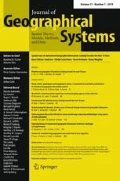Abstract
This paper presents research into optimal dispersion models as applied to central places. The literature regarding location optimization and central places is reviewed and the motivation for employing dispersion models is identified. Models that employ the objective of maximal dispersion in the context of central places are formulated and solved in the context of both single- and multiple-good systems. Two methods for generating multiple-good systems are presented: a multiple-type dispersion model and a K-value constraint set formulation. Sequential solutions to dispersion models demonstrate how a system of central places could develop over time. The solutions to these models generate the patterns of central places expected under the organizing principles of central place theory. The objective of maximal dispersion is posited as both a motivating factor in central place location decisions, and as the optimal outcome of a mature system of central places.





Similar content being viewed by others
References
Beaumont JR (1987) Location–allocation models and central place theory. In: Ghosh A, Rushton G (eds) Spatial analysis and location–allocation models. Van Nostrand Reinhold, New York
Berry BJL, Garrison WL (1958) The functional bases of the central place hierarchy. Econ Geogr 34:145–154
Berry BJL, Parr JB (1988) Market centers and retail location: theory and applications. 2nd edn. Prentice-Hall, Englewood Cliffs
Berry BJL, Pred AR (1965) Central place studies; a bibliography of theory and applications (Regional Science Research Institute, Bibliography series 1.0001) Regional Science Research Institute, Philadelphia
Boots B, Shiode N (2003) Recursive voronoi diagrams. Environ Plann B Plann Des 30:113–124
Bunge W (1966) Theoretical Geography, 2nd revised and enlarged edn. (Lund studies in geography. Series C, general and mathematical geography no. 1). Royal University of Lund, Department of Geography, Gleerup
Christaller W (1966) Central places in southern Germany. Translated by C. W. Baskin Prentice-Hall, Englewood Cliffs
Church RL, Bell TL (1990) Unpacking central place geometry.1. Single level theoretical K-systems. Geogr Analysis 22:95–115
Cronon W (1991) Nature’s metropolis: Chicago and the great west. W.W. Norton, London
Current JR, Storbeck JE (1994) A multiobjective approach to design franchise outlet networks. J Oper Res Soc 45:71–81
Curtin KM. 2002. Models for multiple-type discrete dispersion. Ph.D. dissertation, Department of Geography, University of California, Santa Barbara
Curtin KM, Church RL (2006) A family of location models for multiple-type discrete dispersion. Geogr Analysis 38:247–269
d’Aspremont C, Gabszewicz JJ, Thisse J-F (1979) On Hotelling’s “stability in competition”. Econometrica 47:1145–1150
Devletoglou NE (1965) A dissenting view of duopoly and spatial competition. Economica 32:140–160
Dokmeci VF (1973) An optimization model for a hierarchical spatial system. J Reg Sci 13:439–451
Eaton BC, Lipsey RG (1982) An Economic Theory of Central Places. Econ J 92:56–72
Ebdon D (1988) Statistics in geography, 2nd edn. Blackwell, Oxford
Erkut E (1990) The discrete p-dispersion problem. Eur J Oper Res 46:48–60
Erkut E, Neuman S (1989) Analytical models for locating undesirable facilities. Eur J Oper Res 40:275–291
Erkut E, Neuman S (1990) Comparison of four models for dispersing facilities. INFOR 29:68–86
Fisher HB, Rushton G (1979) Spatial efficiency of service locations and the regional development process. Pap Reg Sci Assoc 42:83–97
Ghosh A, Craig CS (1991) Fransys—a Franchise distribution system location model. J Retailing 67:466–495
Goodchild MF (1984) ILACS: a location–allocation model for retail site selection. J Retailing 60:84–100
Griffith DA (1986) Central place structures using constant elasticity of substitution demand cones: the infinite plane. Econ Geogr 62:74–84
Hakimi SL (1964) Optimum locations of switching centers and the absolute centres and medians of a graph. Oper Res 12:450–459
Hotelling H (1929) Stability in competition. Econ J 39:41–57
Kendall DG (1989) A survey of the statistical theory of shape. Stat Sci 4:87–99
Kohsaka H (1984) An optimization of the central place system in terms of the multipurpose shopping trip. Geogr Analysis 16:251–269
Kuby M (1989) A location–allocation model of Losch’s central place theory—testing on a uniform lattice network. Geogr Analysis 21:316–337
Kuby MJ (1987) Programming models for facility dispersion: the p-dispersion and maxisum dispersion problems. Geogr Analysis 19:315–329
Lösch A (1954) The economics of location, Translated by Woglam WH, Stolper WF. Yale University Press, New Haven
Narula SC, Ogbu UI (1979) An hierarchal location–allocation problem. Omega 7:137–143
Okabe A, Suzuki A (1997) Locational optimization problems solved through Voronoi diagrams. Eur J Oper Res 98:445–456
Prescott EC, Visscher M (1977) Sequential location among firms with foresight. Bell J Econ 8:378–393
Puryear D (1975) A programming model of central place theory. J Reg Sci 15:307–316
Rushton G (1987) Selecting the objective function in location–allocation analyses. In: Ghosh A, Rushton G (eds). Spatial analysis and location–allocation models. Van Nostrand Reinhold, New York
Shier DR (1977) A min–max theorem for p-center problems on a tree. Transp Sci 11:243–52
Storbeck JE (1988) The spatial structuring of central places. Geogr Analysis 20:93–110
Storbeck JE (1990) Classical central places as protected thresholds. Geogr Analysis 22:4–21
Tobler W (1993) Three presentations on geographical analysis and modeling. National Center for Geographic Information and analysis, Santa Barbara
West DS (1981) Testing for market preemption using sequential location data. Bell J Econ 12:129–143
Acknowledgments
The authors appreciate the efforts of Brian J. L. Berry, Thomas L. Bell, and several anonymous reviewers who provided insightful comments on earlier versions of this paper.
Author information
Authors and Affiliations
Corresponding author
Rights and permissions
About this article
Cite this article
Curtin, K.M., Church, R.L. Optimal dispersion and central places. J Geograph Syst 9, 167–187 (2007). https://doi.org/10.1007/s10109-007-0042-4
Received:
Accepted:
Published:
Issue Date:
DOI: https://doi.org/10.1007/s10109-007-0042-4




